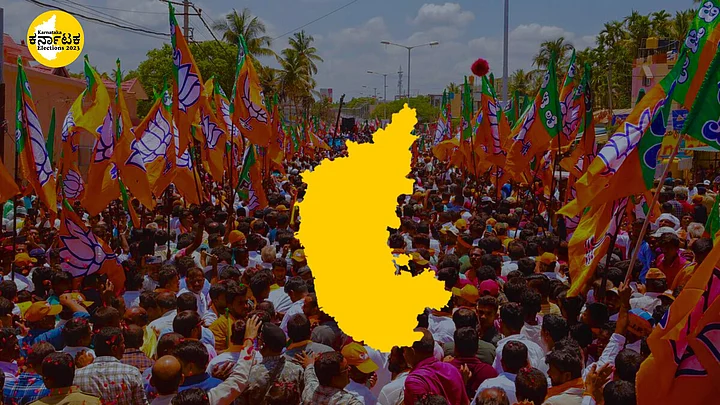Three seemingly unconnected events in three southern states were shaking peninsular India last week, and on them rests Prime Minister Narendra Modi's Bharatiya Janata Party's (BJP) claim of ruling with credible authority over all of the sprawling country. It seems the Karnataka assembly elections this week is more than yet another provincial election.
The 10 May elections will serve as acid tests for two issues: Whether or not Modi is losing his political swag as a national vote puller, and whether Hindutva, the ideology centered around religiosity and culture rather than material gains, works south of the Vindhyas.
A Late Swing Towards Hindutva
Modi led a 26-km election-eve road show in Bangalore in what admirers would call a display of strength and critics an act of desperation. After all, most of the pre-poll surveys show the incumbent BJP losing and Congress getting a decisive majority in the assembly.
Clearly, the BJP's show of thronging crowds and assertive speeches are aimed at wooing not just fence-sitters who may be undecided on where to press their ballot fingers, but also a unique category of Indian voters who do not like to waste their votes: they go with the party that they think has higher chances. BJP's noisy pomp underlined the importance of such optics in influencing voting behaviour.
There is also a clear late swing in the BJP's campaigning agenda towards its familiar Hindutva ideology, usually seen more in the North than in the South. Modi spoke explicitly about the threat of Islamisation through the party's pet theme of "Love Jihad" as he invoked 'The Kerala Story' hitting screens across India. The movie has its storyline woven around Muslim men wooing Hindu girls on the pretext of marriage only to radicalise them is now part of the BJP's campaign toolkit.
Strangely enough, the movie that serious critics have panned as amateurish, exaggerated propaganda, is making waves more in the North than in the South where its plot is supposed to have unfolded -- and on that hangs BJP's aim of injecting Hindutva sentiment in what we might call Dravida zone.
Tamil Nadu and the Dravida Model
This is where we need to look at the events surrounding Modi's road show, both in Karnataka and neighbouring Tamil Nadu. Apart from sharing the river Cauvery, which has been historically an object of their disputes over water-sharing, the two states also have a strong political culture centred around job quotas based on caste and community and ambitions of backward classes that BJP likes to gloss over up North. In its quest for votes, the Modi brigade relies on religiosity and muscular infrastructure projects like airports and snazzy long-distance trains. Its emphasis on education, health, and quotas is only a somewhat reluctant add-on.
Tamil Nadu's chief minister M K Stalin and the state's BJP-appointed governor R N Ravi were locked last week in yet another episode of a long-drawn ideological battle centred around Stalin's description of the quota-goodies-based egalitarian socialist platform that he calls the "Dravida model". Ravi described the model as outdated, inviting a rebuttal from the DMK.
The fact is that Karnataka has also been practicing the Dravida model for decades, though the label has not been used. Rival Lingayat and Vokkaliga groups and backward castes like the Idigas and Kurubas have been jostling for political goodies like quotas in government jobs and college seats to acquire modern educational degrees. The Lingayats have an 800-year history of defying Hindu orthodoxy though their Shiva-worshipping pontiffs may superficially resemble Hindutva leaders.
It is only a coincidence that cricketer Rahul Dravid is from Bangalore and is called The Wall for his defensive batting style. In the race to capture political power in the state capital, the BJP is facing a Dravida wall of another kind.
A Soft Dravida Model for the BJP?
The BJP is only too aware of this.
Congress chief minister Devaraj Urs had tried to unite the OBCs against the Lingayats and Vokkaligas in the 1970s. BJP's current chief minister Basavaraj Bommai has been trying to shuffle the quota pack to eke out more backward caste votes to match what was once a Congress party trick.
But the BJP has been unable to contain the ambitions of Lingayat leaders in stark contrast from the North, where local leaders worship Modi in a culture of sycophancy. The BJP is also fighting a corruption tag in Karnataka more than any other state. Its chosen image as a clean party is in serious doubt here.
Quietly but steadily, the BJP has been embracing the Dravida model and the politics of goodies in a soft way, even as Modi publicly frowns on the culture of freebies funded by the taxpayer that he calls "revdis". The BJP's Karnataka manifesto, apart from its Hindutva-laced promise of bringing in a Uniform Civil Code that targets Muslim marriage laws, also promises ration kits for the poor and three free cooking gas cylinders per year to poor families.
You could say Karnataka is the country's main battleground in an ideological war between Hindutva champions and social justice warriors. Only the coastal Mangalore belt seems easily within the Hindutva grasp. Elsewhere, the BJP has had to crawl through a minefield of other factors. The May 13 verdict will show whether Hindutva has made a dent in Dravida-style politics, or is only a northern juggernaut stopped on its tracks.
(The writer is a senior journalist and commentator who has worked for Reuters, Economic Times, Business Standard, and Hindustan Times. He can be reached on Twitter @madversity. This is an opinion article and the views expressed are the author’s own. The Quint neither endorses nor is responsible for them.)
(At The Quint, we question everything. Play an active role in shaping our journalism by becoming a member today.)
